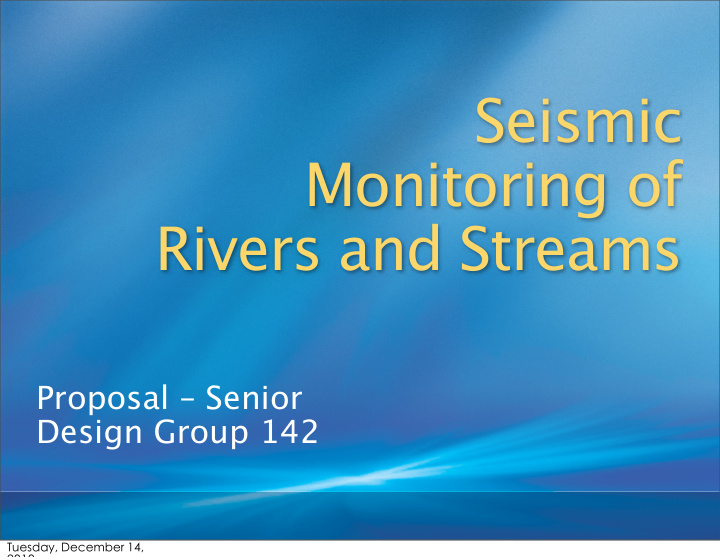



Seismic Monitoring of Rivers and Streams Proposal – Senior Design Group 142 Tuesday, December 14, 2010
Project Members Students: Wei Yu (Electrical Engineering) Ayodele Asaolu (Electrical Engineering) Muhammad U. Khokhar (Electrical Engineering) Advisor: Quing Zhu (ECE Department) Sponser: U.S. Geological Survey – O ffj ce of Groundwater Tuesday, December 14, 2010
OUTLINE BACKGROUND Introduction • USGS • Purpose & Goals • Seismic Waves/Geophones The Problem Project Goals Design Hardware Alternative Design Software TIMELINE BUDGET QUESTIONS? Tuesday, December 14, 2010
U.S. Geological Survey Scientific agency of the US government. Study of landscape, natural resources, and the natural hazards that threaten it. Divided into four major science disciplines, concerning biology, geography, geology, and hydrology. Tuesday, December 14, 2010
USGS Purpose and Goals Branch of Geophysics - Groundwater Information Providing technical support and guidance Applied Research Improve monitoring methods Monitor hydrologic processes Borehole-radar methods for ground-water investigations Technology Transfer Improve monitoring methods Testing of newly developed geophysical technology Tuesday, December 14, 2010
Seismic Waves/Geophones Waves of energy that travel through earth Sensors: Seismographs, Hydrophones (in water), Accelerometers, Geophones Waves propagation velocity depends on density and elasticity of the medium Two types of Seismic Waves: Body and Surface B-waves: faster and based on temperature, composition, phase. S-waves: lower frequency, long duration, high amplitude Tuesday, December 14, 2010
The Problem Measuring flow of water can be di ffj cult • Numerous locations Technology Cost Price • Sensory E ffj ciency • Durability Sturdy • Resilience to harsh natural weather/geographical • conditions? Tuesday, December 14, 2010
Project Goal Phase 1: Developing an inexpensive data acquisition-storage device which incorporates the use of a geophone. • Gathering viable data from a river or stream • Analyzing data for noise and inconsistencies • Designing filter to reduce noise • Selecting specific components for design needs • Programming and testing microcontroller circuit Tuesday, December 14, 2010
Phase 2: Developing a sustainable energy power source for the device. Phase 3: Create a means of accessing the device via satellite or mobile device Tuesday, December 14, 2010
Preliminary Hardware Design Program Code Solar Amplifier Panel Microcontrolle USB r Geophone Storage Filter Device Data Transmission Tuesday, December 14, 2010
Geophone N W E Converts Ground Movement into S Voltage Spring-mounted magnetic mass moving within a wire coil Waves passing through the earth have a three-dimensional nature Three-component or 3-C geophones Tuesday, December 14, 2010
Main Hardware Unit Microcontroller Filter Circuit Data transfer option USB Device SD Card Tuesday, December 14, 2010
Design Microcontroller Model Processes quality information to external transfer device USB-Device Adequate Storage Availability Durability Tuesday, December 14, 2010
Alternative Design Use of acceleration sensor Multiple direction measurement Low pass and Butterworth filters Tuesday, December 14, 2010
Research Defining the most suitable filter for our device Low-pass/high-pass filter A need to search for an amplifier that would fulfill the given task Research on possible alternative energy sources Solar energy, Battery, Both Tuesday, December 14, 2010
Programming Collecting and storing data DATA ADC SRAM Computing and averaging data TIMER ADC EEPROM Transmitting data FLASH EEPROM USART DRIVE Tuesday, December 14, 2010
Testing Test geophone Lab testing Field testing Data comparison Test the input circuit Test the microcontroller’s program Test the device in the working environment Tuesday, December 14, 2010
Future Improvements Solar Panel Self-sustaining power source Cheap and e ffj cient Eco-friendly Data Transmission Accessibility to data via satellite/mobile device Tuesday, December 14, 2010
Milestones Finished Research of the Geophone In progress Analysis of the Geophone Designing simulated setup Upcoming Building and programming circuit Testing circuit-geophone setup Tuesday, December 14, 2010
Time Line Sep Oct Nov Dec Jan Feb Mar Apr May Research and Planning Design Circuit Purchase Components Develop Program Assemble System Test System Debugging Finalize Project Tuesday, December 14, 2010
Budget Budget Estimation Test equipment $100 Microcontroller $50 Instrumental Amplifier $50 USB interface $5 Programming interface $150 Board fabrication $200-$300 Portable power source $100 Other components $100 Tuesday, December 14, 2010
Questions? Tuesday, December 14, 2010
Recommend
More recommend